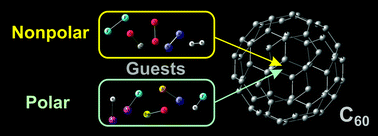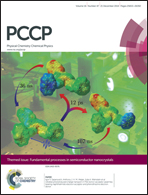Encapsulation of diatomic molecules in fullerene C60: implications for their main properties†
Abstract
The endohedral complexes of diatomic guest molecules H2, N2, O2, F2, HF, CO, LiH, LiF, BN, and BeO with C60 have been characterized computationally by employing second-order Møller–Plesset (MP2) theory and its density-fitting local (DF-LMP2) variant. The interaction energies, equilibrium geometries, dipole moments and harmonic vibrational frequencies of these complexes have been systematically calculated. It was found that all guest molecules are stabilized inside the C60 cage, with the most pronounced stabilization effect (of about 50 kcal mol−1) observed for the polar covalent BeO and BN molecules. It is noteworthy that the normally short-lived BN molecule is the only guest molecule that was found to chemisorb on the inner surface of C60. When encapsulated, all guest molecules (except for BN) exhibit bond elongation (up to 0.07 Å) and, consequently, a red shift in vibrational stretching frequencies. In fact, the calculated vibrational properties of the H2@C60 complex agree well with those derived from experiment. The C60 geometry is not perturbed significantly upon encapsulation, but a subtle tendency to decrease the carbon–carbon bond alternation is observed. Polar guest molecules inside C60 are located at an off-center position and a significant decrease in their dipole moments upon encapsulation is observed. The importance of explicitly taking into account electron correlation effects, as well as full geometry relaxation, to yield a correct description of the complexes investigated is clearly demonstrated. The present results may serve as a guide for future attempts to synthesize such complexes employing the “molecular surgery” approach.


 Please wait while we load your content...
Please wait while we load your content...